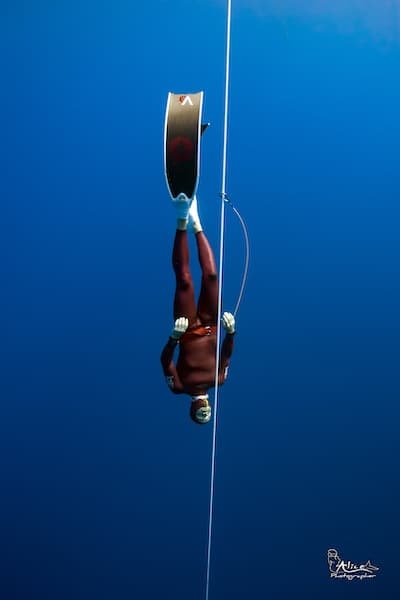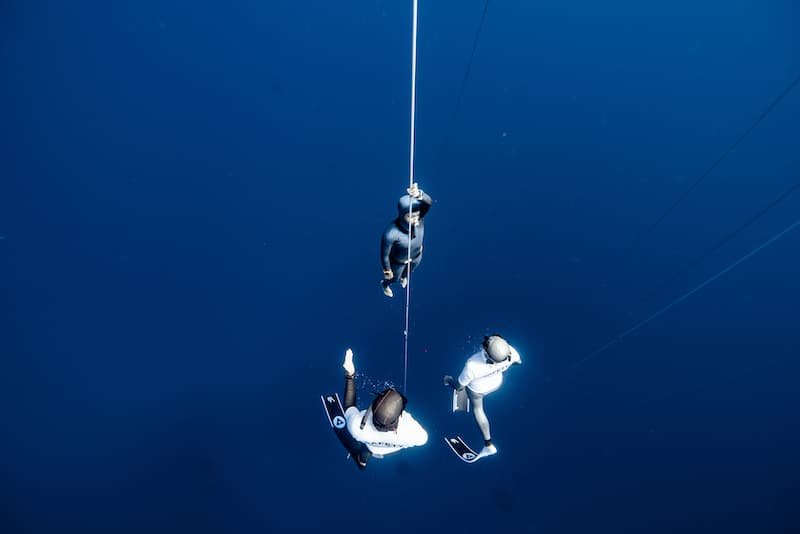
 Nick Pelios
Freediver, Creator
Nick Pelios
Freediver, Creator

 Nick Pelios
Freediver, Creator
Nick Pelios
Freediver, Creator
Freefall is an essential aspect of every dive, often the most exhilarating for many enthusiasts. Nevertheless, both novice and experienced freedivers may not have fully optimized their techniques. Here's a guide on essential considerations for buoyancy, timing, and body posture that should be at the forefront of your mind.
Buoyancy, a pivotal element in the sport, plays a crucial role in the initial phases of every descent. As the diver plunges into the aquatic realm, the first 10 meters or so mark a zone dominated by positive buoyancy. In this realm, the watery medium exerts an upward force, necessitating purposeful actions on the part of the freediver to overcome its influence. This is where the artistry of kicking or skillfully pulling the line comes into play, depending on the particular discipline being pursued.
The positive buoyancy encountered in this initial stage necessitates a display of strength and finesse. To continue the descent, the freediver must infuse each kick with power and amplitude, countering the buoyant force pushing them toward the water's surface. The aquatic environment becomes a dynamic battleground where the diver's energy contends with the inherent tendency to rise.
However, as the journey progresses into the intermediate depths, typically ranging from 10 to 15 meters, a subtle transformation occurs. Here, the buoyancy shifts towards neutrality, providing a temporary respite to the diver. In this nuanced zone, a delicate equilibrium is achieved, allowing the freediver to experience a moment of near stillness. During this phase, the kicks required to maintain descent become more measured, striking a balance between movement and repose.
The fascinating interplay between the diver and buoyancy reaches its zenith beyond the 15-20 meter mark, where the diver can finally relinquish the exertion of constant kicking. This marks the transition into the coveted freefall phase, a liberated descent into the depths where gravity takes the lead, and the diver becomes an elegant passenger in the aquatic realm. The positive buoyancy that once necessitated forceful kicks is now superseded by the allure of weightlessness, creating an experience that is both meditative and exhilarating.
Understanding buoyancy, therefore, becomes not only a technical skill but also an intimate communion with the aquatic environment. It requires a keen awareness of the shifting dynamics and a mastery of techniques to navigate the buoyant forces at play, ultimately allowing the freediver to revel in the sheer joy of controlled descent.

Timing, emerges as a pivotal factor governing the graceful transition from active propulsion to the liberating phase of freefall. It involves a nuanced understanding of when to relinquish the rhythmic kicks and embrace the weightless descent, optimizing the entire diving experience.
For an intermediate-level freediver navigating depths of around 30 to 50 meters, the orchestration of timing begins with achieving neutral buoyancy within the depth range of 10 to 15 meters. This delicate balance between buoyant forces and the diver's intentional efforts sets the stage for the subsequent freefall. The journey towards neutral buoyancy requires finesse and calibration, influenced by variables such as wetsuit buoyancy, individual body composition, and the unique characteristics of the aquatic environment.
The decision of when to initiate the freefall phase depends on a myriad of factors. The freediver, attuned to their equipment and surroundings, gauges the opportune moment to cease kicking and surrender to the gravitational pull. The transition typically unfolds around the 15-meter mark, but variations abound based on individual preferences, experience levels, and the specific demands of the dive.
In this delicate dance of timing, freedivers may choose to incorporate small kicks even after the commencement of freefall, strategically injected to maintain a desired descent speed. This adaptive approach allows for a dynamic and controlled descent, adding a layer of finesse to the freefall experience. The art of timing thus encapsulates a keen awareness of one's body, equipment, and the fluid dynamics of the underwater world.
Factors such as the type of water—whether it's the distinct qualities of freshwater or the saline embrace of the ocean—contribute to the intricate calculus of timing. Each dive becomes a dialogue between the freediver and the aquatic environment, requiring a continuous adjustment of timing based on the unique conditions encountered beneath the surface.
For competitive freedivers, this artistry of timing takes on an added layer of complexity, involving strategic considerations and nuanced adjustments to maximize efficiency and performance. Yet, at its core, timing remains a deeply personal and intuitive aspect of the freediving experience, where the diver's connection with the underwater world is heightened through the mastery of when to relinquish control and embrace the profound beauty of freefall.

Body posture, an integral facet of freediving, transcends mere aesthetics and ventures into the realm of functionality and efficiency. As freedivers progress from the propulsive phase to the exquisite descent of freefall,
In the aftermath of the kicking phase, as the freediver gracefully glides through the water column, the quest for a streamlined posture becomes paramount. The extension of the knees and ankles assumes significance, contributing to hydrodynamic efficiency. This streamlined elegance isn't merely a visual consideration but a practical one, reducing drag and allowing the diver to slice through the water with minimal resistance.
The posture's nuances extend beyond the lower extremities, encapsulating the strategic alignment of the head and hands. Maintaining a neutral head position, with the neck in alignment with the hand designated for equalization, becomes a fundamental aspect. This not only enhances the diver's hydrodynamic profile but also ensures a harmonious progression through the depths. Concealing the elbow during the descent is equally pivotal, minimizing disruptions to the streamlined form.
For those necessitating frequent equalization, the posture extends its influence to the positioning of the hand and nose. Keeping the hand poised and ready for equalization maneuvers ensures a seamless and uninterrupted descent. Alternatively, for divers who struggle with equalization over extended distances, the strategic placement of one hand in a pocket facilitates timely and efficient equalization, harmonizing with the rhythm of the descent.
The debate over arm positioning often surfaces in the freediving community. While some opt for the arrow position, stretching their arms overhead, the critical caveat lies in ensuring complete alignment. The arms should seamlessly extend in parallel with the torso to avoid diagonal misalignment. This meticulous attention to detail prevents energy loss and minimizes tension in the shoulders, contributing to a more relaxed and sustainable descent.
In acknowledging the diversity of preferences among freedivers, the choice of body posture becomes a highly personalized aspect. Competitive freedivers may adopt an arrow position for optimal speed, while those engaged in more recreational pursuits might find comfort in keeping their arms at their sides. This acknowledgment of individual style adds a layer of subjectivity to the art of body posture, allowing each diver to tailor their descent technique according to their comfort and objectives.
In essence, body posture in freediving transcends the superficial, evolving into a dynamic and purposeful element of the descent. It intertwines aesthetics with functionality, and its mastery enhances the overall freediving experience, ensuring that the descent into the aquatic depths is not just a journey but a symphony of form and function.